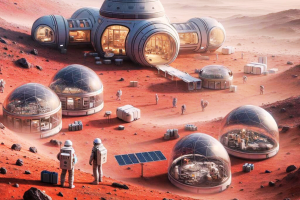Life on Mars: NASA calls for volunteers to take part in year-long simulation

NASA has put out a call for applicants to participate in its next simulated one-year Mars surface mission to help inform the space agency’s plans for human exploration of the Red Planet. The second installment of the three anticipated ground-based missions, known as the Crew Health and Performance Exploration Analog (CHAPEA 2), is set to commence in the spring of 2025.
.@NASA is seeking applicants to participate in its next simulated one-year Mars surface mission to help inform the agency’s plans for human exploration of the Red Planet. The second of three planned ground-based missions called CHAPEA (Crew Health and Performance Exploration… pic.twitter.com/5duSwLHfhx
— NASA Space Operations (@NASASpaceOps) February 16, 2024
Throughout the mission, the four chosen crew members will reside in a 3D-printed habitat spanning 1,700 square feet, located in Houston. Named the Mars Dune Alpha, the habitat replicates the hurdles of a Martian mission, including limited resources, equipment malfunctions, delayed communications, and various environmental pressures. The crew’s responsibilities involve conducting simulated spacewalks, operating robots, maintaining the habitat, exercising, and growing crops.
NASA is currently open to applications on the CHAPEA website until April 2. These are paid positions, although the exact amount of the payment has not been disclosed by NASA.
How does the selection process work?According to a statement on its website, the selection of crew members will follow NASA’s additional standard criteria for astronaut candidate applicants. As a result, applicants would need a master’s degree in a STEM (Science, Technology, Engineering, Mathematics) field, such as engineering, mathematics, biological sciences, physical sciences, or computer science from an accredited institution.
Participants should also have a minimum of two years of professional experience in a STEM field or at least one thousand hours of pilot time. Eligibility also extends to candidates who have made significant progress in a doctoral program in a STEM field, have earned a medical degree, or have completed a test pilot school program.
Volunteers with a bachelor of science degree in a STEM field coupled with four years of professional experience, or those who have completed military officer training, may also be considered.
What are the CHAPEA missions for?CHAPEA missions are said to provide important scientific data for the validation of systems and the development of solutions aimed at future Mars expeditions. As the first CHAPEA crew passes the halfway mark of their year-long mission, NASA is attempting to leverage insights from these simulated missions to improve support for crew health and performance on Mars journeys.
The space agency has been working on a number of missions to Mars including sending astronauts using nuclear-powered rocket engines. It is reported that it takes around seven or eight months for a conventional spacecraft powered by burning liquid fuel to reach Mars. Nuclear rocket engines, however, have the potential to cut that time by at least a third.
Steve Isakowitz, CEO of The Aerospace Corporation, believes that artificial intelligence (AI) controlled satellites and permanent habitation of the Moon and Mars are in the cards for the future of space exploration and defense.
Featured image: DALL·E
The post Life on Mars: NASA calls for volunteers to take part in year-long simulation appeared first on ReadWrite.
